
Press Cuttings about the Walk
Press cutting from the Lanark Advertiser, Thursday 7th April 2005
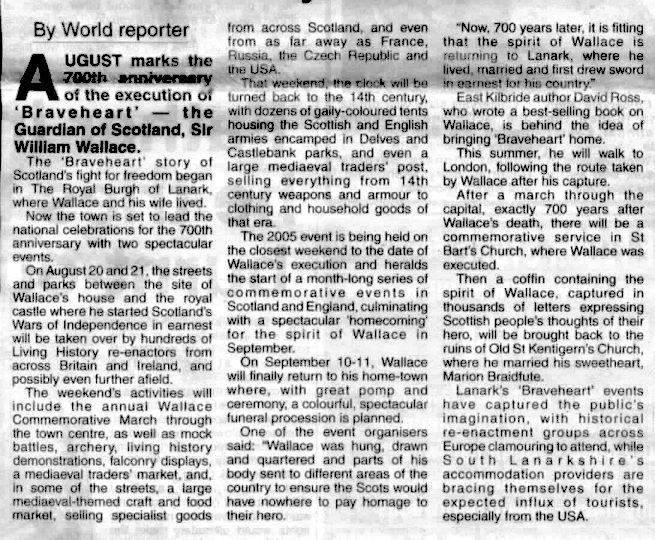
The Sunday Post, 7th November 2004 - article about the Walk

Historic Scotland Magazine, September 2004 - review of Desire Lines
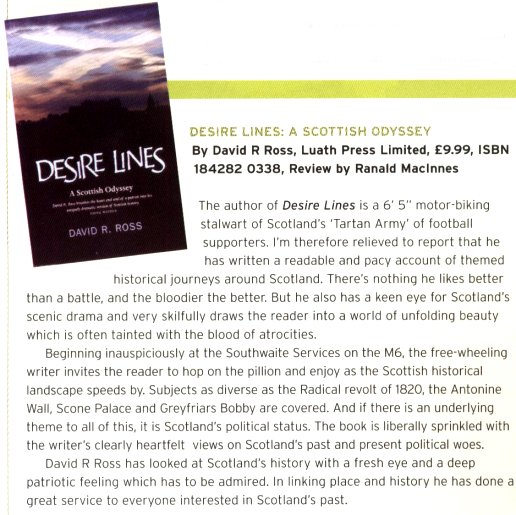
The Scots Magazine, September 2004 - review of Desire Lines
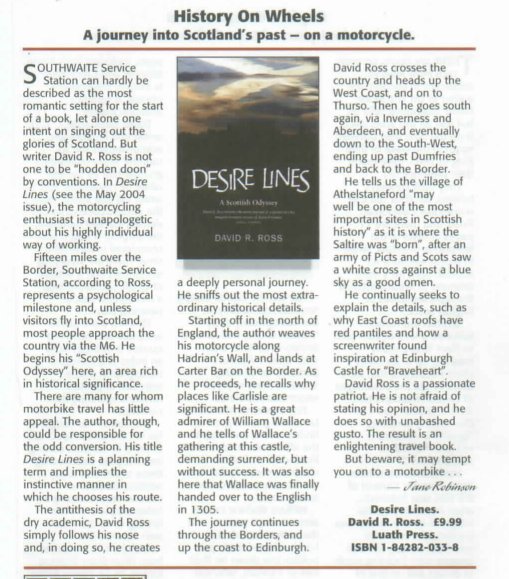
BBC History, March 2004 - Counterblast debate
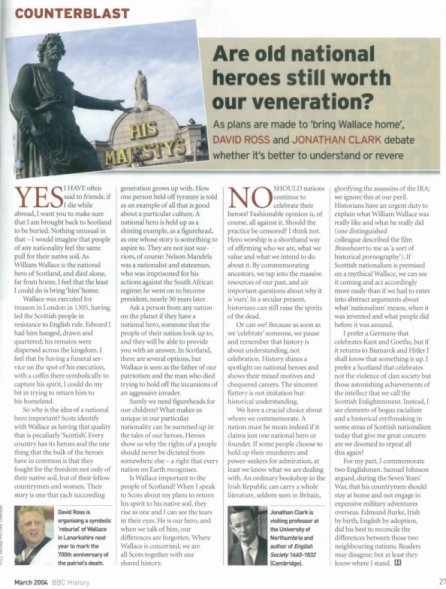
BBC History - March 2004 page 27
COUNTERBLAST
Are old national heroes still worth our veneration? As plans are made to bring Wallace home , David Ross and Jonathan Clark debate whether it s better to understand or revere.
Yes:
I have often said to friends, if I die while abroad, I want you to make sure that I am brought back to Scotland to be buried. Nothing unusual in that, as I would imagine that people of any nationality feel that same pull for their native soil. As William Wallace is the national hero of Scotland, and he died alone and far from home, I felt the least I could do was to bring him home. Wallace was destroyed utterly by Edward I, who ensured his ashes were scattered to the winds, but I felt that by having a funeral service on the spot of his murder, with a coffin there to symbolically capture his spirit, I could do my bit in trying to return him to his homeland.
Why is the idea of a national hero important? Wallace is the man whom Scots identify with as having that quality that is peculiarly Scottish . Every country has its heroes, and the one thing that the bulk of them have in common is that they fought for the freedom of not only their native soil, but for the liberty of their fellow countrymen and women. Their story is the one that each succeeding generation of their countries children grow up with. How this person held off tyranny is told as an example of all that is good about their particular culture. A national hero is held up as a shining example, as a figurehead, as one whose story is something to aspire to. They are not all warriors of course. Attaturk is the man who most Turks put forward when asked. Nelson Mandela went from prisoner to head of state.
Ask a person from any nation on the planet if they have a national hero, someone that the people of their nation look up to, and there may be some options, but they will be able to provide you with an answer. In Scotland too, there are several options, but Wallace is seen as the father of our patriotism, and the man who died trying to hold off the incursions of an aggressive invader.
Surely we need figureheads for our children? What makes us unique in our particular nationality can be summed up in the tales of our heroes, and why the rights of one people should never be dictated from somewhere else is a right that every nation on Earth recognises.
And is Wallace important to the people of Scotland? When I speak to them of my plans to return his spirit to his native soil, they rise at the end as if as one, and I can see the tears in their eyes. He is our hero, and when we talk of him our differences are forgotten. Where Wallace is concerned we are all Scots together with our shared history.
David Ross is organising a symbolic reburial of Wallace in Lanarkshire next year to mark the 700th anniversary of the patriot s death.
No:
Should nations continue to celebrate their heroes? Fashionable opinion is, of course, all against it. Should the practice be censored? I think not. Hero worship is a shorthand way of affirming who we are, what we value, and what we intend to do about it. By commemorating ancestors, we tap into the massive resources of our past, and air important questions about why it is ours . In a secular present, historians can still raise the spirits of the dead.
Or can we? Because as soon as we celebrate someone, we pause and remember that history is about understanding, not celebration. History shines a spotlight on national heroes and shows their mixed motives and chequered careers. The sincerest flattery is not imitation but historical understanding.
We have a crucial choice about whom we commemorate. A nation must be mean indeed if it claims just one national hero or founder. If some people choose to hold up their murderers and power-seekers for admiration, at least we know what we are dealing with. An ordinary bookshop in the Irish Republic can carry a whole literature, seldom seen in Britain, glorifying the assassins of the IRA; we ignore this at our peril.
Historians have an urgent duty to explain what William Wallace was really like and what he really did (one distinguished colleague described the film Braveheart to me as a sort of historical pornography ). If Scottish nationalism is premised on a mythical Wallace, we can see it coming and act accordingly more easily than if we had to enter into arguments about what nationalism means, when it was invented and what people did before it was around.
I prefer a Germany that celebrates Kant and Goethe, but if it returns to Bismarck and Hitler, I shall know that something is up. I prefer a Scotland that celebrates not the violence of clan society but those astonishing achievements of the intellect that we call the Scottish Enlightenment. Instead, I see elements of bogus racialism and a historical mythmaking in some areas of Scottish nationalism today that gives me great concern: are we doomed to repeat all this again?
For my part, I commemorate two Englishmen. Samuel Johnson argued, during the Seven Years War, that his countrymen should stay at home and not engage in expensive military adventures overseas. Edmund Burke, Irish by birth, English by adoption, did his best to reconcile the differences between those two neighbouring nations. Readers may disagree; but at least they know where I stand.
Jonathan Clark is visiting professor at the University of Northumbria and author of English Society 1660-1832 (Cambridge).
Daily Record, 16th January 2004 - the latest riposte from the staunchly Scottish 'Voice of Scotland'!
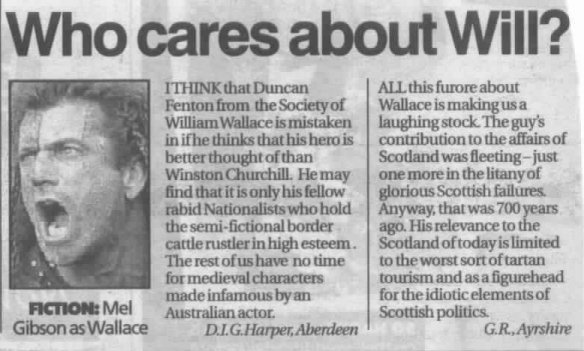
Daily Record, 15th January 2004 - A letter from Duncan Fenton:
Re: James Traynor's comments about the 700th commemoration of William Wallace's execution. As usual, Traynor has missed the point. Wallace's earthly body was dismembered and scattered deliberately so that the Scottish people would forget him. Seven centuries later, his spirit is most definitely not forgotten. And just as importantly, the ideal for which he strived has not been forgotten. When these lists of "top 100" famous people are trooped out every now and again, Wallace is always there. But in 700 years time, who will remember Winston Churchill, William Shakespeare, or - dare I say it - Jonny bloody Wilkinson?
Every country honours its heroes - it is a measure of respect. This is the Scottish people's way of repecting ours. The chance for the people of Scotland to put their thoughts on Wallace into words is not "madness" as Traynor puts it, but is an opportunity to show respect for a war hero, which Wallace undoubtedly was.
Maybe Traynor is at last showing his true colours, a latter-day Menteith with no love for his country, and less for his fellow Scots.
Daily Record, 13th January 2004 - joke 'columnist' Traynor must have taken some stick. Here he goes trying to justify his stance again in the alleged 'Voice of Scotland'!

Daily Record, 9th January 2004 - apparently not everyone agreed with their joke 'columnist' Traynor...
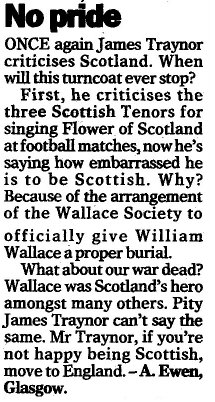
The Independent, 6th January 2004
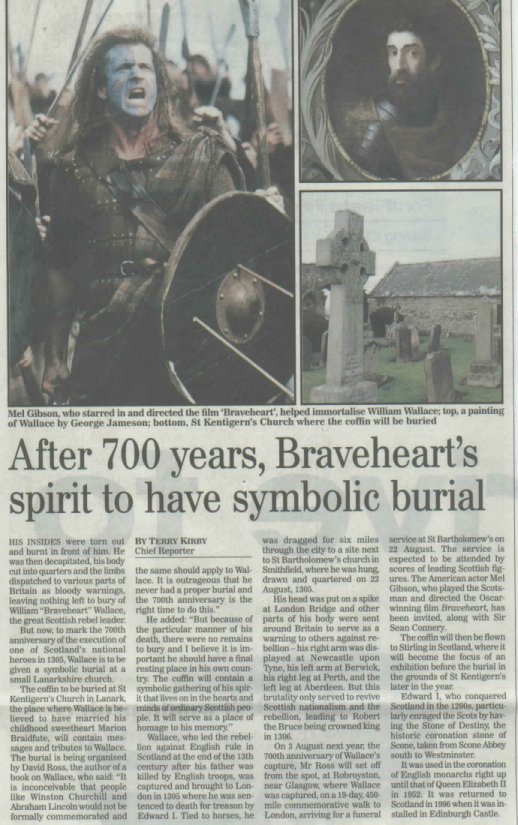
Daily Record, 6th January 2004 - the self-styled "Voice of Scotland"...
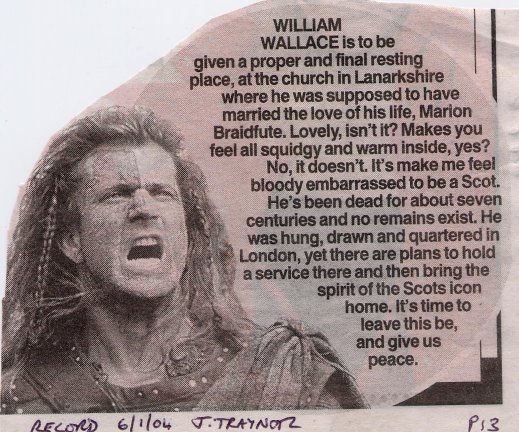
Press and Journal, 5th January 2004
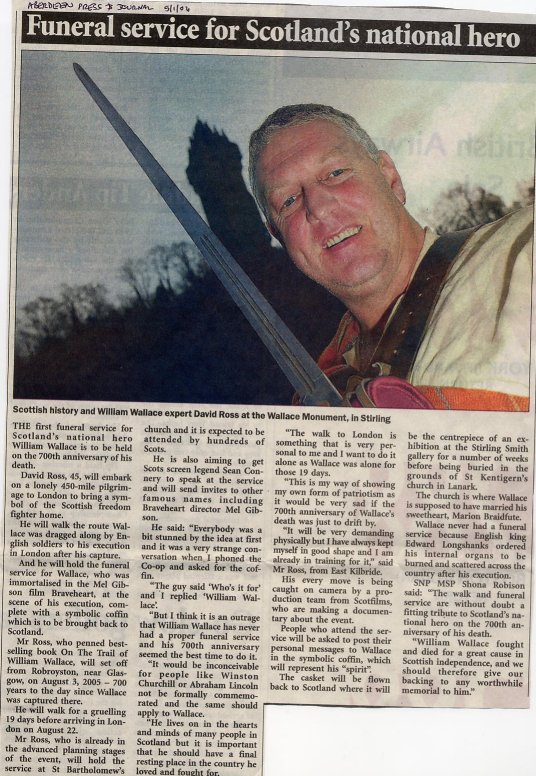
Daily Mirror, 5th January 2004
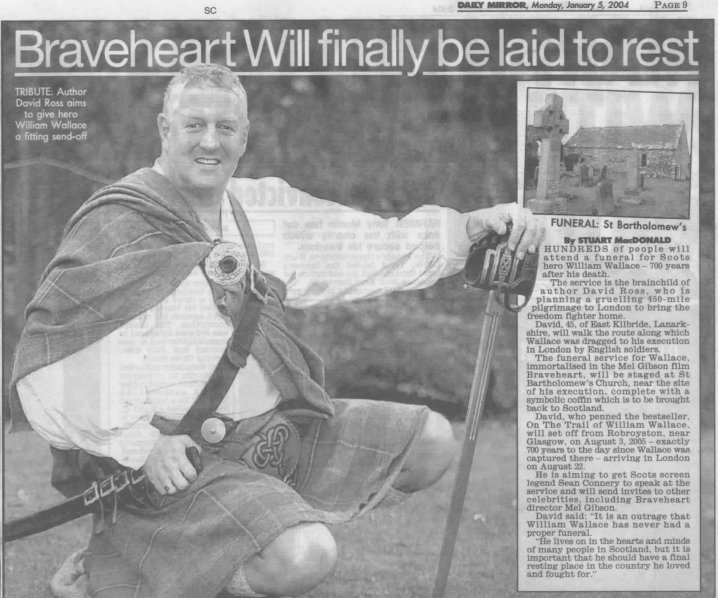
The Sun, 5th January 2004
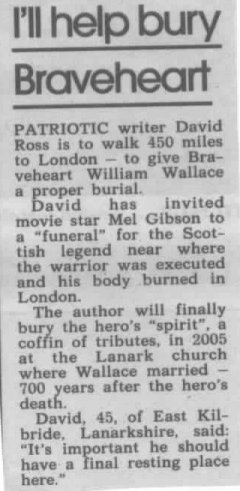
Daily Record, 5th January 2004
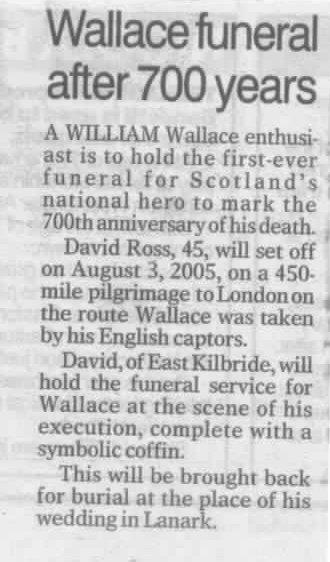
Scotland on Sunday, 4th January 2004
STUART MacDONALD
HE RESTS in the hearts and minds of Scots as an icon of the nation s fighting spirit yet Braveheart legend William Wallace has never been granted a burial place fit for a national hero. But now, on the 700th anniversary of his gruesome death, Wallace is to finally get a permanent resting place at the Lanarkshire church where he is believed to have married his sweetheart. However, first there will be an extraordinary re-enactment of the last days of Wallace s life which led up to his horrific death.
Wallace author David Ross, will embark on a 450-mile pilgrimage to London to bring the spirit of the freedom fighter home. Although no remains of Wallace exist, St Bartholemew s, the historic church next to where he was executed in Smithfield, London, has been booked for a service and a coffin commissioned. The service is expected to be packed out by hundreds of Scots patriots and fans of the Oscar-winning William Wallace movie Braveheart, directed by and starring Mel Gibson, who has been invited along with Sir Sean Connery. Following the service, Ross plans to bring the casket, which will be filled with messages from those attending the service, back to St Kentigern s Church in Lanark for burial.
Wallace never received a burial as his body was hung drawn and quartered and the remains burnt and scattered to the four corners of the country. His grisly demise came after he was captured and brought to London on August 22, 1305, charged with treason against ruthless King Edward II, known as Edward Longshanks . He was sentenced to death, tied to the tails of horses and dragged for six miles through the city before being hung, drawn and quartered at St Bartholomew s on August 23.
Ross, who wrote the book, On The Trail of William Wallace, will set off from Robroyston, near Glasgow, on August 3, 2005 - exactly 700 years to the day since Wallace was captured there. He will walk for a gruelling 19 days before arriving in London on August 22. He said: "I think it is an outrage that William Wallace has never had a proper funeral service and his 700th anniversary seemed the best time to do it. It would be inconceivable for people like Winston Churchill or Abraham Lincoln not to be formally commemorated and the same should apply to Wallace. He lives on in the hearts and minds of many people in Scotland but it is important that he should have a final resting place in the country he loved. The walk to London is something that is very personal to me and I want to do it alone as Wallace was alone for those 19 days. This is my way of showing my own form of patriotism as it would be very sad if the 700th anniversary of Wallace s death was just to drift by. "It will be very demanding physically but I have always kept myself in good shape and I am already in training for it." Ross, from East Kilbride, Lanarkshire, added: "It was a very strange conversation when I phoned the Co-op and asked for the coffin. The guy said Who s it for, and I replied, William Wallace . Everybody is a bit stunned by the idea at first but when you think about it, he is our national hero and it is only right that we should commemorate him. Wallace s legacy has been greatly helped by the film Braveheart and I think it is he who brings our patriotism to the fore more than anybody else."
People who attend the service will be asked to post their personal messages to Wallace in the symbolic coffin, which will represent his "spirit". The casket will be flown back to Scotland where it will be the centrepiece of an exhibition at the Smith Art Gallery in Stirling for a number of weeks before being buried in the grounds of St Kentigern s. The church is where Wallace married his sweetheart Marion Braidfute and the Lanark Wallace Trust were keen to have the coffin buried there as they feel the legendary warrior s historic links to the town have been neglected for too long. Margo Steel, of the Lanark Wallace Trust, said: "When I heard about David s idea I thought it was fantastic and really wanted to get involved. There was talk of burying the coffin in Stirling but I pushed the case for Lanark as there is no official memorial to him here. It would be fantastic for tourism. Who wouldn t want to come and see the final resting place of a Scottish hero like William Wallace."
The event - which is to be filmed by production company Scotfilms - has also attracted the support of the SNP. Spokeswoman Shona Robison said: "The walk and funeral service are without doubt a fitting tribute to Scotland s national hero on the 700th anniversary of his death. "I am sure this idea will capture the imagination of the Scottish public who still hold William Wallace in such great esteem. William Wallace fought and died for a great cause in Scottish independence, and we should therefore give our backing to any worthwhile memorial to him."
National hero
WILLIAM Wallace was undisputed leader of the Scottish resistance forces during the first years of the struggle to free Scotland from English rule at the end of the 13th century. Records of Wallace s life, just like the memorable epic filmed by Mel Gibson (below), are often inaccurate. This is partly because early accounts of his heroic deeds are speculative and partly because he inspired such fear in the minds of English writers at the time, that they demonised him. Wallace was born around 1270, probably near Ellerslie (now Elderslie), in Ayrshire. His father was Sir Malcolm Wallace, Laird of Elderslie and Auchinbothie, a small landowner and little-known Scottish knight. His mother is believed to have been the daughter of Sir Hugh Crawford, Sheriff of Ayr. At the time of Wallace s birth, Alexander III had already been on Scotland s throne for more than 20 years. King Edward I came to the throne of England in 1272, two years after Wallace was born.
The Ottawa Citizen, Canada, January 2004
By Joanne Laucius
William Wallace, the 14th century Scottish hero popularized in the film Braveheart, will get a final burial, thanks to a history buff who calls himself the "biker historian."This August, on the 700th anniversary of Wallace's gruesome execution in London, David R. Ross, a writer whose books have included the Scottish bestseller On the Trail of William Wallace, plans to embark on a 700-kilometre walk from Robroyston, near Glasgow, to London. Even though there are no remains of Wallace, a casket has been commissioned.
There is to be a funeral service at the historic St. Bartholemew's, located next to where Wallace was put to death in Smithfield, then outside London. The actors Mel Gibson, who starred as Wallace in Braveheart, as well as the Scottish actor and nationalist Sean Connery, will be invited. The casket, filled with messages, will be returned for burial to St. Kentigern's church in Lanark, Scotland, where Wallace married Marion Braidfute. She was killed by the English, an event that sparked Wallace's fight against them. Mr. Ross says it's time for Scots to get some closure on their national hero, whose name has become synonymous with Scottish nationalism. "I can't imagine any other nation on the planet not getting closure on their national hero," he said. "He lives in the hearts and minds of the people of Scotland." The trip will take the same 19 days it took Wallace to be brought to London on horseback. There is a not a fragment of Wallace's body remaining, although there are legends about the final resting spots of at least one of his limbs, said Mr. Ross. Wallace was tied to the tails of horses, dragged for about eight kilometres, then hung, drawn and quartered. His organs were burned completely and his limbs were displayed in different parts of Scotland, including his left arm, which was reputedly displayed at Stirling Bridge, the scene of his great victory against the English.
According to those legends, the arm was later buried in an abbey nearby. Mr. Ross, who has written six books about Scottish history, said this story may not be true. But Edward I wanted to completely erase any evidence that Wallace ever existed. Wallace refused to swear fealty to the English king Edward I, known as "Longshanks" and "Hammer of the Scots." "Wallace cut through the idea of the feudal system. It was not fealty, but the soil of Scotland itself. He was ahead of his time," said Mr. Ross. Mr. Ross, a self-trained historian who jokingly says his family history "goes back to the 1950s," has had a lot of support for his walk, which will be about 50 kilometres a day. There is no record to the route Wallace was taken, but the six-foot-five Mr. Ross, 45, who often makes public appearances either in biker's leathers or full highland dress, plans to travel on quiet roads, and says he has been working out in preparation of the gruelling pace. So far, everything about the walk and the funeral has been donated, including the casket. As Mr. Ross tells it, he called on one of Scotland's biggest funeral companies and asked for a coffin. "They asked who it was for, and I said, 'William Wallace.' "
Celtic Heritage, November / December 2003
David's article in a Canadian magazine
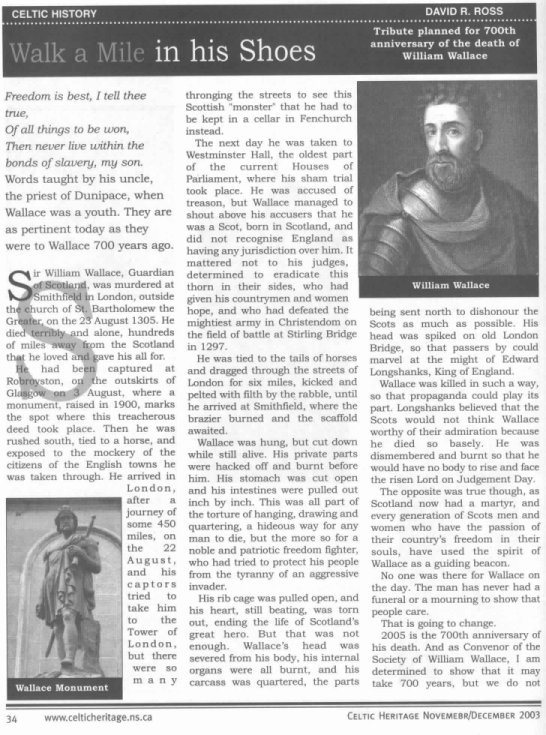
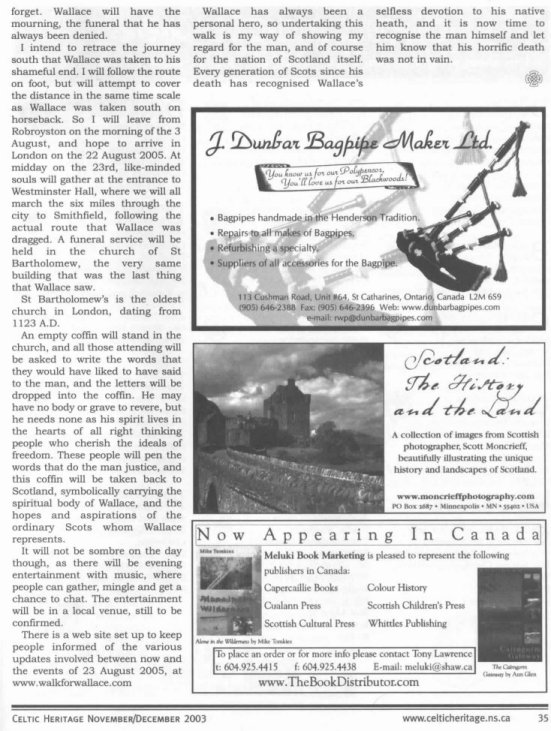
Lanark and Carluke Advertiser, 1st December 2003
Wallace inspires patriotic feelings in different ways in all types of Scots
This letter from the Carluke and Lanark Gazette, from December 2003, shows both sides of the coin.

Lanark and Carluke Advertiser, 13th November 2003
Bringing Wallace home 700 years on
William Wallace could be brought home to Lanark in 2005 as part of a spectacular event to commemorate the 700th anniversary of the national hero's brutal execution in London.
The recently established Lanark Wallace Trust Steering Committee heard on Sunday that this was one way of putting the Royal Burgh firmly on the Wallace map.
Although Wallace married and lived in the town, and started the campaign for freedom there after he slew the Lanark's English Sheriff, these historic links have long been neglected. Now the Trust want that to change, and are working on a number of ideas which will put Lanark firmly on the Wallace tourist trail.
Well known historical author David Ross already plans his own spectacular commemoration in 2005, and on Sunday he met with members of the group to discuss Lanark's possible involvement. David's plans include the re-enactment of Wallace being betrayed and captured in Scotland and dragged to London to be executed. This event took 19 days, having been done in record time to ensure that Wallace's execution would be the major spectacular event at the start of the highly popular St. Bartholomew's Fair, held annually in London at the time. There will then be a re-enactment of the particularly brutal execution, followed by a funeral service in St. Bartholomew's on August 23rd.
David went on to explain to the group that Wallace was disembowelled and dismembered alive by Edward Longshanks of England for a quite specific purpose. His body parts were displayed above sewers in cities all over England, his head in London, of course. This was supposed to ensure that he would never stand a whole man before the Gates of Heaven, in the - forlorn - hope that the Scots would consider him 'unworthy', and to ensure that he would never have a last resting place.
However, he may now have a symbolic last resting place in Lanark, possibly by Old St. Kentigern's where he was married. After the service in London, Wallace's symbolic coffin will be brought back to Scotland to lie in state in Stirling.
"The public will be invited to place their thoughts on Wallace and Scotland, be it an opinion, a quote, a poem, or simply a piece of tartan or some other personal symbol of love or loyalty, into the coffin. In this way, the coffin will indeed be recognised and accepted worldwide as containing the essence of Scotland's greatest son, the spirit of Sir William Wallace. After 700 years, the warrior poet and Guardian of Scotland will have a last resting place," said Mr Ross. And he asked the group: "Let me bring William Wallace home! The last resting place of William Wallace should be in Lanark, preferably by St. Kentigern's Church where he met and married the one true love of his life oher than Scotland itself, Marion Braidfute."
The 2005 Wallace event is expected to attract worldwide publicity, and a TV drama documentary on the subject, and involving Mr Ross, is already under way. In fact, the author was due in Lanark with representatives from the TV production company today (Thursday). At Sunday's meeting, the Lanark Wallace Group committed itself to doing its utmost to ensuring that Wallace will indeed finally come home to Lanark and, if successful in its endeavours, Wallace will be entombed in a custom-built crypt at a spectacular event in Lanark on September 11, 2005, providing a focal point for Scots at home and abroad.
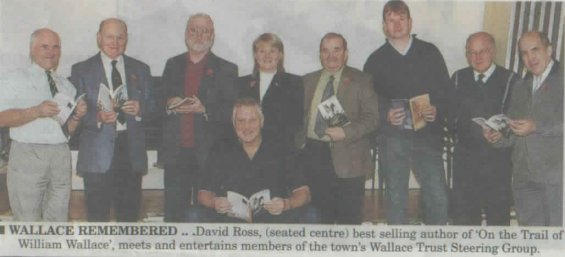
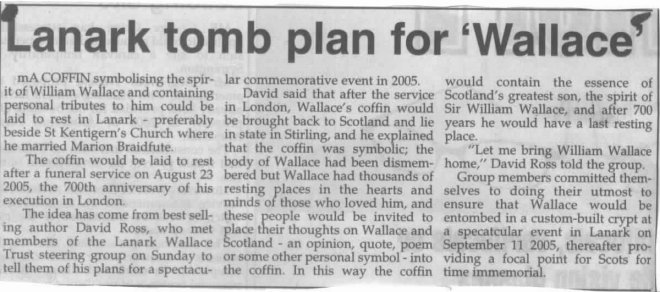
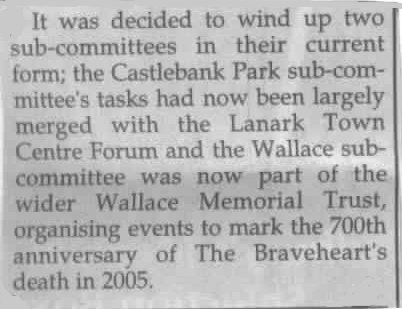
Perthshire Advertiser, 11th November 2003
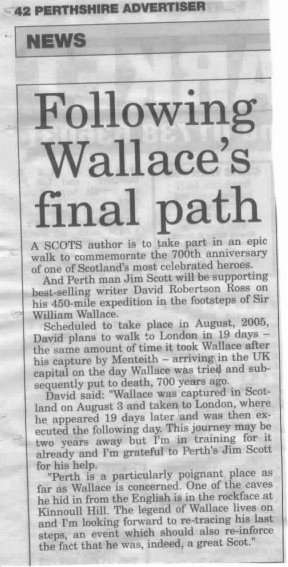
"Dundee Courier", Wednesday 15th October 2003
A Scots historian is to recreate the last, anguished days of a national hero when he walks from Robroyston to London. Supported by Perth man Jim Scott, David Robertson Ross will walk from the place William Wallace was captured to his place of execution.
The event commemorates the 700th anniversary of Wallace's capture and will mirror the 19 days it took English soldiers to drag him south, with a church service in London completew with a coffin containing messages of support. Those involved are hoping for donations and sponsorship and more details can be found at www.walkforwallace.com
"Dundee Evening Telegraph", Thursday 18th September 2003
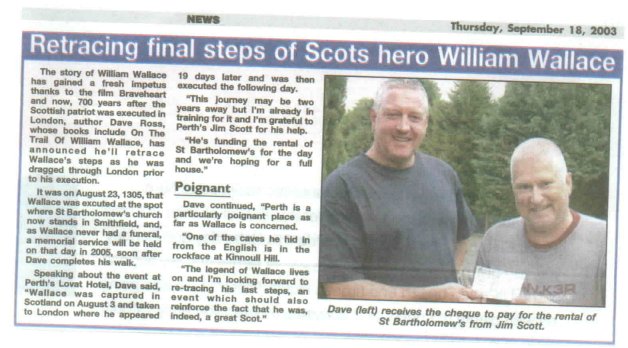
Retracing final steps of Scots hero William Wallace
The story of William Wallace has gained a fresh impetus thanks to the film Braveheart and now, 700 years after the Scottish patriot was executed in London, author Dave Ross, whose books include On The Trail Of William Wallace, has announced he'll retrace Wallace's steps as he was dragged through London prior to his execution.
It was on August 23, 1305, that Wallace was executed at the spot where St Bartholomew's church now stands in Smithfield, and, as Wallace never had a funeral, a memorial service will be held on that day in 2005, soon after Dave completes his walk.
Speaking about the event at Perth's Lovat Hotel, Dave said, "Wallace was captured in Scotland on August 3 and taken to London where he appeared 19 days later and was then executed the following day. This journey may be two years away but I'm in training for it already and I'm grateful to Perth's Jim Scott for his help. He's funding the rental of St Bartholomew's for the day and we're hoping for a full house."
Dave continued, "Perth is a particularly poignant place as far as Wallace is concerned. One of the caves he hid in from the English is in the rockface at Kinnoull Hill. The legend of Wallace lives on and I'm looking forward to re-tracing his last steps, an event whcih should also reinforce the fact that he was, indeed, a great Scot."
Article written for a North American magazine "The Scottish Banner", September 2003
WALK FOR WALLACE 2005
Sir William Wallace, Guardian of Scotland, was murdered at Smithfield in London, outside the church of St. Bartholomew the Greater, on the 23 August 1305. He died terribly and alone, hundreds of miles away from the Scotland that he loved and gave his all for.
He had been captured at Robroyston, on the outskirts of Glasgow on 3 August, where a monument, raised in 1900, marks the spot where this treacherous deed took place. Then he was rushed south, tied to a horse, and exposed to the mockery of the citizens of the English towns he was taken through. He arrived in London, after a journey of some 450 miles, on the 22 August, and his captors tried to take him to the Tower of London, but there were so many thronging the streets to see this Scottish monster that he had to be kept in a cellar in Fenchurch instead.
The next day he was taken to Westminster Hall, the oldest part of the current Houses of Parliament, where his sham trial took place. He was accused of treason, but Wallace managed to shout above his accusers that he was a Scot, born in Scotland, and did not recognise England as having any jurisdiction over him. It mattered not to his judges, determined to eradicate this thorn in their sides, who had given his countrymen and women hope, and who had defeated the mightiest army in Christendom on the field of battle at Stirling Bridge in 1297.
He was tied to the tails of horses and dragged through the streets of London for 6 miles, kicked and pelted with filth by the rabble, till he arrived at Smithfield, where the brazier burned and the scaffold awaited.Wallace was hung, but cut down while still alive. His private parts were hacked off and burnt before him. His stomach was cut open and his intestines were pulled out inch by inch. This was all part of the torture of hanging, drawing and quartering, a hideous way for any man to die, but the more so for a noble and patriotic freedom fighter, who had tried to protect his people from the tyranny of an aggressive invader.
His rib cage was pulled open, and his heart, still beating, was torn out, ending the life of Scotland s great hero. But that was not enough. Wallaces' head was severed from his body, his internal organs were all burnt, and his carcass was quartered, the parts being sent north to dishonour the Scots as much as possible. His head was spiked on old London Bridge, so that passers by could marvel at the might of Edward Longshanks, King of England.
Wallace was killed in such a way, so that propaganda could play its part. Longshanks believed that the Scots would not think Wallace worthy of their admiration because he died so basely. He was dismembered and burnt so that he would have no body to rise and face the risen Lord on Judgement Day.
The opposite was true though, as Scotland now had a martyr, and every generation of Scots men and women who have the passion of their countries freedom in their souls, have used the spirit of Wallace as a guiding beacon. No-one was there for Wallace on the day. The man has never had a funeral or a mourning to show that people care.
That is going to change.
2005 sees the 700th anniversary of his death. And as Convenor of the Society of William Wallace, I am determined to show that it may take 700 years, but we do not forget. Wallace will have the mourning, the funeral, that he has always been denied. I intend to retrace the journey south that Wallace was taken to his shameful end. I will follow the route on foot, but will attempt to cover the distance in the same time scale as Wallace was taken south on horseback. So I will leave from Robroyston on the morning of the 3 August, and hope to arrive in London on the 22 August 2005. At midday on the 23, like minded souls will gather at the entrance to Westminster Hall, where we will all march the 6 miles through the city to Smithfield, following the actual route that Wallace was dragged. A funeral service will be held in the church of St Bartholomew, the very same building that was the last thing that Wallace saw.
St Bartholomew s church is the oldest church in London, dating from 1123AD. An empty coffin will stand in the church, and all those attending will be asked to write the words that they would have liked to have said to the man, and the letters will be dropped into the coffin. He may have no body or grave to revere, but he needs none, as his spirit lives in the hearts of all right thinking people who cherish the ideals of freedom. These people will pen the words that do the man justice, and this coffin will be taken back to Scotland, symbolically carrying the spiritual body of Wallace, and the hopes and aspirations of the ordinary Scots whom Wallace represents.
It will not be all sombre on the day though, as there will be evening entertainment with music, where people can gather, mingle and get a chance to chat. The entertainment will be in a local venue, still to be confirmed.
There is a web site set up to keep people informed of the various updates involved between now and the events of 23 August 2005. You may access it on .
www.walkforwallace.com
There is a facility for anyone who may have the means to help finance this project, as it is a non profit event being carried out with the money of those patriotic enough to care, and not financed by any agencies.The walk to London is some 450 miles, which I will do alone, as it is a long road, not to be lightly undertaken, and I have trained hard to make sure that I will succeed. Anyone who wishes to attend the commemoration in London will be welcome, and they are encouraged to leave any comments on the web site mentioned above.
As detailed in my book, the best selling "On the Trail of William Wallace" Wallace has always been a personal hero, so undertaking the Walk is a my way of showing my regard for the man, and of course for the nation of Scotland itself.
I hope that Scots, native to Scotland, and ex-pats alike, will realise the solemnity of this occasion, and the chance we have to repay a man who gave his all for Scotland. Every generation of Scots since have recognised Wallaces selfless devotion to his native heath, and it is now time to recognise the man himself, and let him know that his horrific death was not in vain.
Wallace, when a youth, was taught these words by his uncle, the priest of Dunipace
Freedom is best, I tell thee true,
Of all things to be won,
Then never live within the bonds of slavery, my son.
As pertinent today as they were to Wallace 700 years ago.
David R. Ross,
Convenor, The Society of William Wallace.